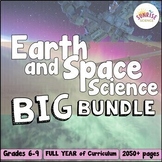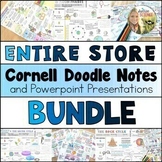Earth and Space Science Notes Doodle Notes Middle School Science | Cornell Notes
- Zip
What educators are saying
Products in this Bundle (16)
showing 1-5 of 16 products
Also included in
- This is a bundle of all of my resources for teaching Earth and Space Science at the middle school level! These resources include a mix of Cornell Doodle Notes, lab activities, inquiry activities, digital lessons and units, projects, and pixel art digital content review activities.✨ Please note thatPrice $327.00Original Price $450.24Save $123.24
- This is a growing bundle of ALL of my Science Cornell Doodle Notes resources. This bundle currently contains Cornell Doodle Notes and the associated Powerpoint / Google Slides Presentations for 48 science topics. The price at this point reflects what is in the bundle at this time, plus 20% off. As aPrice $189.00Original Price $244.25Save $55.25
Description
This is a growing bundle of all of my Cornell Doodle Notes on Earth and Space Science topics. This resource currently contains Cornell Doodle Notes, the associated Powerpoint / Google Slides Presentations, and (for most) Google Slides versions of the notes for 16 topics.
The topics currently included are:
- layers of the Earth
- plate tectonics
- continental drift & seafloor spreading
- types of rocks
- the rock cycle
- mechanical and chemical weathering
- erosion and deposition
- relative age dating of rocks
- the water cycle
- weather variables
- weather systems
- Earth's rotation and revolution
- the moon phases
- the reason for the seasons
- solar and lunar eclipses
- gravity and orbiting
✨ Get 20% off of these resources by purchasing this bundle!
✨ GROWING! I'm making more sets of Earth and Space Science doodle notes! If you buy this bundle today, you will receive all future Cornell Doodle Notes on Earth and Space Science topics for free! As an additional resource is added, the price of this bundle will rise accordingly. You will receive notices under your My Purchases when a new resource is added to this bundle. If you Follow Me you will also receive an email from TPT when this bundle is updated.
Here are some things to know about Cornell Doodle Notes:
✓ A Powerpoint comes with each of these notes, and it is also available as a Google Slides presentation so that you can opt to share it with your students via Google Classroom
✓ Each set of notes also has a Sum It Up section or practice page to help students engage further with the information in the notes
✓ Each of the notes sets are scaffolded for two or three different levels (same content, different amounts of writing)
✓ Packed with visuals, examples, and analogies for brain-friendly learning
✓ No prep other than printing out the scaffolded note versions and sharing the Google link if necessary
✓ Easy to leave for a substitute
✓ Fun for students to color, which will help to aid retention of the content
✓ Supplements three-dimensional learning with rich content
✓ Distance Learning Digital Note-taking Options:
- Assign Google Slides version (many topics include this), which includes student directions and Google Tools and Fonts in a sidebar; easy to assign in Google Classroom
- Assign scaffolded PDF version using Kami browser extension (Learn about this option by downloading THIS FREEBIE!)
- Assign using TPT's Digital Activity Tool
✓ What Other Teachers are Saying:
"I adore these doodle notes. I use them all the time! My students love them too. They give a great review for my kiddos and a great resource for them to look back on to study from. Everything is organized beautifully as well. Love, love, love these. I own at least 5 different ones." (Melissa B.)
"The visuals and explanations are fantastic! I love how everything is so organized and appreciate the plethora of options that we get with this product. My 8th graders enjoyed the notes!" (Science Sparkles)
"My students love this resource. I've been trying out different types of doodle notes and these are perfect. There are different difficulty levels so I don't end up with dead space where half the class is finished and the other half is still trying to copy the work down. We will definitely be using them in the future!" (Bailey O.)
"These notes were so easy for my students to follow along with and they allowed them to gain a good understanding of the topic." (Jana K.)
"My students are loving these doodle notes--I SO appreciate the differentiation that's already done!" (Kelly B.)
✨ Please view the PREVIEW for more visuals of what is included!
✨ You may also be interested in these Cornell Doodle Notes Bundles:
ENTIRE STORE of Cornell Doodle Notes Bundle
Physical Science Cornell Doodle Notes Bundle
Chemistry Topics Cornell Doodle Notes Bundle
Earth Science Cornell Doodle Notes Bundle
Please note that these resources are not editable due to font and clip art licensing agreements. Also, if you plan to share this resource among a group of teachers, that's awesome! But, please purchase additional licenses!
Doodle notes is a trademarked term used with permission. Please visit doodlenotes.org for more information.
Thank you for looking!
Sunrise Science







